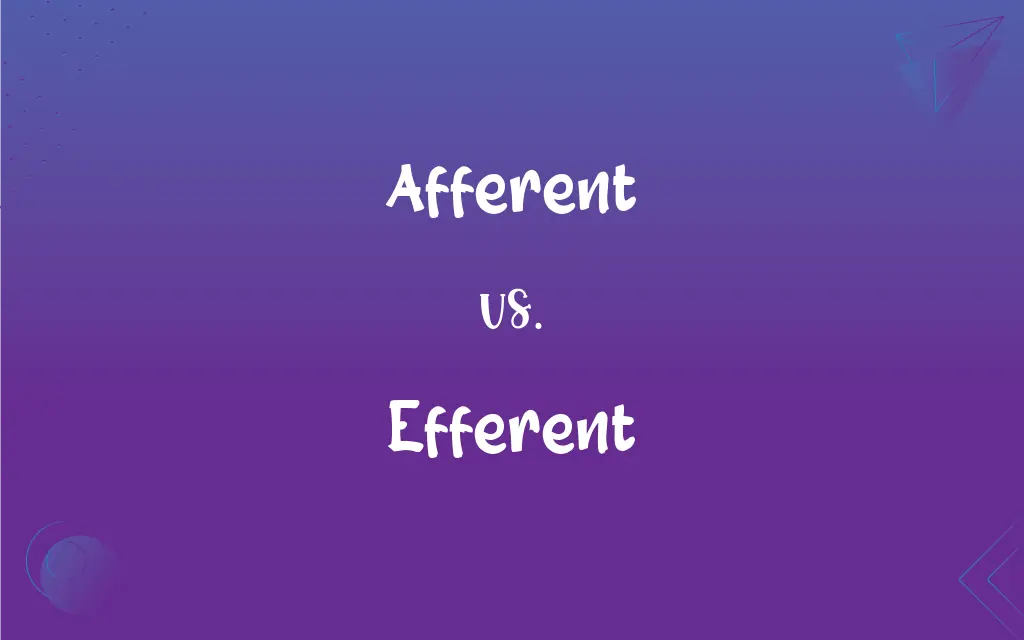Afferent vs. Efferent: What's the Difference?
Edited by Aimie Carlson || By Harlon Moss || Published on December 5, 2023
Afferent refers to the transmission of signals towards a central point, typically in the nervous system, while efferent refers to the conduction of signals away from a central point.

Key Differences
Afferent pathways carry sensory information from the body to the brain. However, efferent pathways convey commands from the brain to the body.
In the context of the nervous system, afferent neurons transmit signals to the central nervous system. Efferent neurons, on the other hand, carry neural impulses away from the central nervous system.
Afferent signals are involved in sensory perception, alerting the brain to external or internal stimuli. Efferent signals are responsible for motor responses and actions.
The afferent system includes sensory neurons and pathways. In contrast, the efferent system includes motor neurons that activate muscles and glands.
Afferent input is crucial for the brain to process and react to the environment. Efferent output enables the body to respond to these brain commands.
ADVERTISEMENT
Comparison Chart
Direction of Signal
Towards the central nervous system (CNS)
Away from the CNS
Function
Carries sensory information
Carries motor commands
Type of Neurons
Sensory neurons
Motor neurons
Role in Body Response
Detects and transmits stimuli
Executes responses and actions
Physiological Example
Transmitting touch sensation to the brain
Sending signals to muscles for movement
ADVERTISEMENT
Afferent and Efferent Definitions
Afferent
Afferent pathways convey sensory information to the central nervous system.
The afferent nerves in your hand help you feel heat.
Efferent
Efferent connections activate muscles and glands.
Efferent signals cause your heart to beat faster.
Afferent
Afferent neurons are responsible for transmitting sensory signals.
Afferent neurons alert the brain to changes in temperature.
Efferent
Efferent processes enable response to brain commands.
Efferent nerves help you withdraw your hand from a hot surface.
Afferent
Afferent refers to the inward flow of information in the nervous system.
Afferent pathways are critical for sensory perception.
Efferent
Efferent neurons are involved in motor responses.
Efferent fibers stimulate muscle contraction.
Afferent
Afferent processes are essential for awareness of external stimuli.
Afferent signals from the skin detect pressure and pain.
Efferent
Efferent refers to the outward transmission of neural signals.
Efferent pathways are essential for executing physical actions.
Afferent
Afferent connections are involved in sending signals to the brain.
Afferent fibers in the eyes transmit visual information.
Efferent
Efferent pathways transmit signals from the brain to the body.
Efferent neurons control the movement of your arm.
Afferent
Carrying inward to a central organ or section, as nerves that conduct impulses from the periphery of the body to the brain or spinal cord.
Efferent
Directed away from a central organ or section.
Afferent
Carrying towards.
An afferent nerve carries impulses from the body to the brain.
Efferent
Carrying impulses from the central nervous system to an effector.
Afferent
An afferent structure or connection
Efferent
An efferent organ or body part, such as a blood vessel.
Afferent
Bearing or conducting inwards to a part or organ; - opposed to efferent; as, afferent vessels; afferent nerves, which convey sensations from the external organs to the brain.
Efferent
Carrying away from.
An efferent nerve carries impulses from the brain to the body.
Afferent
Of nerves and nerve impulses; conveying sensory information from the sense organs to the CNS;
Afferent nerves
Afferent impulses
Efferent
Carried outward.
Efferent impulses are those conveyed by the motor or efferent nerves from the central nervous organ outwards.
Efferent
A duct or stream that carries away.
Efferent
Conveying outward, or discharging; - applied to certain blood vessels, lymphatics, nerves, etc.
Efferent
An efferent duct or stream.
Efferent
Of nerves and nerve impulses; conveying information away from the CNS;
Efferent nerves and impulses
FAQs
Where are afferent neurons located?
Throughout the body, transmitting sensory information to the brain.
Where are efferent neurons located?
They originate in the central nervous system, extending to muscles and glands.
What does afferent mean?
Transmitting sensory information to the central nervous system.
What is an example of an afferent pathway?
Nerves carrying touch sensations from the skin to the brain.
Can a neuron be both afferent and efferent?
Typically, neurons are either afferent or efferent, not both.
How do afferent pathways contribute to perception?
They transmit sensory information that the brain interprets as perception.
What does efferent mean?
Transmitting motor commands away from the central nervous system.
How do efferent pathways facilitate action?
They carry signals to muscles and glands to produce physical responses.
What is the role of efferent neurons in digestion?
They control the movement of muscles in the gastrointestinal tract.
Are efferent pathways involved in voluntary actions?
Yes, they carry out commands for voluntary movements.
What senses are linked to afferent neurons?
All senses, including touch, vision, hearing, taste, and smell.
How does damage to efferent nerves affect the body?
It can lead to muscle weakness or paralysis.
Are afferent pathways involved in pain sensation?
Yes, they transmit pain signals to the brain.
What medical conditions affect afferent nerves?
Conditions like neuropathy and multiple sclerosis.
What is an example of an efferent pathway?
Nerves that stimulate muscle contraction for movement.
What medical conditions affect efferent nerves?
Conditions like amyotrophic lateral sclerosis and spinal cord injuries.
How does damage to afferent nerves affect the body?
It can result in loss of sensation or altered sensory perception.
Can efferent nerves regulate glandular secretions?
Yes, they control the activation of glands.
Are afferent pathways involved in reflex actions?
Yes, they transmit the initial sensory input in reflex arcs.
How do afferent and efferent pathways interact?
Together, they form a communication network for sensory input and motor output.
About Author
Written by
Harlon MossHarlon is a seasoned quality moderator and accomplished content writer for Difference Wiki. An alumnus of the prestigious University of California, he earned his degree in Computer Science. Leveraging his academic background, Harlon brings a meticulous and informed perspective to his work, ensuring content accuracy and excellence.
Edited by
Aimie CarlsonAimie Carlson, holding a master's degree in English literature, is a fervent English language enthusiast. She lends her writing talents to Difference Wiki, a prominent website that specializes in comparisons, offering readers insightful analyses that both captivate and inform.







































































